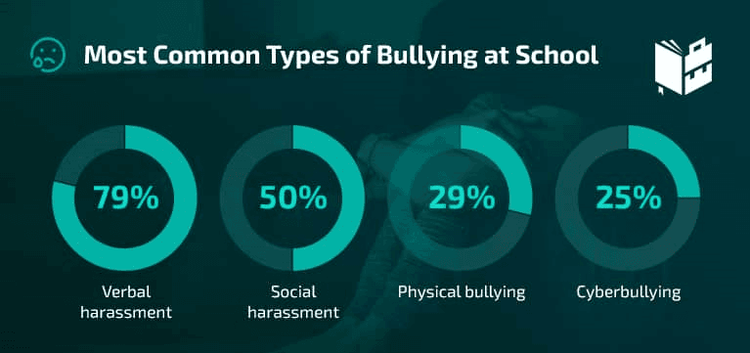Emilie Burke
Last updated:Nov 23, 2023
Although it pains parents to consider their child being bullied or, worse, engaging in bullying behaviour themselves, the reality is that over half of all children are involved in some capacity, whether as a perpetrator, victim, or observer. Thus, it’s likely that you will have to deal with it eventually. You have options for supporting your child in case they are the target of bullying.

Bullying Statistics Every Parent Should Know

1. 90% of students in 4th to 8th grade admit they’ve experienced bullying
2. 1 in 6 high school kids reports being bullied online.
3. Just 39% of high school students reported bullying to an adult
4. 70 percent of pupils have experienced bullying
5. Every day, more than 160,000 children choose not to attend school due to bullying
Types of bullying
Bullying occurs when there is a power imbalance in a relationship and one person or group intentionally and repeatedly hurts another person or group. It can occur both in person and virtually.
Bullying at school
Even though bullying is occasionally dismissed as “part of growing up” or “kids being kids,” consider the child who experiences bullying on a daily basis—either physically, socially, or online. Consider 12-year-old Rebecca Sedwick, who killed herself in Florida after being bullied by two young girls for a year.Rebecca committed suicide because she found the bullying to be so severe and upsetting.
Or take the case of the eight-year-old kid who writes to Santa Claus about being teased for being overweight by his twin sister: “Dear Santa… I no longer want a car with remote control or a helicopter, even though I once desired both. It’s unfair that students at my sister’s school continue to tease her. She needs your assistance, and I begged that they would stop.”
By ignoring bullying, parents, teachers, and students convey the message that bullying is either unavoidable or acceptable. Establishing a welcoming atmosphere where inclusiveness, tolerance for diversity, and mutual trust between educators and students are crucial are the answers to these problems. This kind of setting can prevent bullying from occurring and provide students who witness bullying the knowledge and resources they need to respond appropriately when it does.
Internet bullying
This is a topic that is even more relevant and significant as many students begin their second year of online education, especially for the younger generation. Since they’ve all grown up with technology, their first morning ritual is to check social media. With a lifestyle that is becoming more and more online, cyberbullying can take many different forms.
In contrast to cyberbullying, cybergangs promote organised out-of-group behaviour. One of its tactics is to incite people to cooperate in order to intentionally hurt another group. “Naming and shaming,” sometimes referred to as “human flesh searches” in China, is another form of internet harassment in which victims’ contact information or personal identities are disclosed, leaving them open to abuse, harassment, and stalking.
The advent of this especially vicious and sneaky kind of cyberbullying puts users of the internet, platform operators, and society at large in grave danger. Cybermoulding has more detrimental effects than cyberbullying since victims are attacked repeatedly by a group of people, making it harder for them to defend themselves. Furthermore, the use of derogatory and deceptive content in internet crowdfunding sparked strong reactions and polarised society.
Why do kids keep bullying a secret?
It’s never simple to bully someone, especially a youngster. They feel helpless and helpless when they are being bullied. In an attempt to regain control, kids frequently attempt to manage things on their own. Additionally, they worry about their parents’ reaction and dread being perceived as weak because some adults make a big deal out of it and get in touch with the school. Others worry about receiving negative feedback.
Bullies, on the other hand, fear being discovered by their parents and are too embarrassed to do so. In addition, some bullies vent their resentment on children they believe to be weaker than them because they believe that no one can relate to what they’re going through.
Are you worried your child is being bullied?
Bullying is a significant issue that may cause much distress for both you and your child. It could be difficult for kids to discuss being bullied or bullying others.
Even though you’re not positive that your kid is being bullied, there may be other indicators that something is wrong. Watch out for:
1.disturbed sleep
2.bed-wetting
3.head and stomach aches
4.problems with concentration
5.changes in behaviour and attitude
6.school refusal
7.bullying other children
8.damaged or missing clothes / money / property
9.asking for more money than usual or stealing money
10.withdrawn or changes in their usual behaviour patterns or attitude
11.distressed or emotional and finds it hard to articulate their feelings
12.changes in their eating patterns
13.changes in their online activity
14.showing evidence of self-harming or even for extreme cases, threatening suicide
15.is unusually tired without a reasonable explanation
16.has strange marks or bruises on their body; some people might not want to alter for PE
17.arrives at school empty-handed or without a packed lunch on multiple occasions.
18.seems to be terrified of being by themselves and needs more adult interaction
Don’t jump to conclusions though, as there may be other causes for these symptoms. Is your youngster experiencing any additional problems? Are they finding the assignments at school difficult? Have they and a friend have a falling out? Has your family had any changes as a result of a new baby, a death in the family, a divorce, or a separation?
Give your kids the opportunity to speak and listen to what they have to say.
Supporting your child
It’s critical to make an effort to listen without becoming agitated or disturbed. Set aside your personal emotions, take a seat, and pay attention to what your child is telling you. By “playing back” to them what you have heard, you can reflect what you have heard. Inquire about their preferred course of action so they don’t feel left out of the decision-making process when it comes to the next stages. If your child reports the bullying, they can face retaliation, so they might require a lot of help.
Tell your kids that it’s not their fault. Remind them that bullying doesn’t mean weakness and that the bully has problems of their own, which is why they feel compelled to make other people feel the same way. Help your child develop resilience so that they can project confidence. Body language and tone of voice have a powerful communicational power.
Bullies are more likely to cease if your child gives them the idea that they’re not disturbed. Sometimes people say hurtful things to get a certain reaction or to upset people. Play out bullying situations and have your kids practise the reactions. Discuss how our looks, voices, and bodies all convey signals in the same way that our words do.
Keep the bullying from taking over their lives. Assist your youngster in learning new skills. Urge them to participate in self-defense or drama as a club or hobby. This gives you a chance to meet new people, boost your confidence, and help you see the situation in perspective.
Things that may not help
Refrain from chasing after the bully, the head teacher, or their parents. Children typically fear this very response, which can exacerbate bullying. Never encourage your kids to yell or hit back. It really doesn’t work, and if your child lacks confidence—which is the case with most bullied kids—it will only make them feel more stressed and anxious.
If your child has braved enough to tell you about bullying, never discount their experience. It is heartbreaking to be advised to handle things on your own or that it’s all a part of growing up. Do not tell them to ignore it, as this may lead children to believe that bullying is something that should be accepted.
Dealing with your feelings
When you learn that your child is being bullied, you could feel scared, powerless, angry, upset, guilty, or helpless. While your personal childhood experiences might aid in empathy and problem-solving, they can also provide obstacles. Consider your feelings before acting; otherwise, you might not be able to assist as much as you would like.
If your youngster wants to discuss the issue with friends and other adults, don’t be annoyed with them. It could be beneficial for you to have a private conversation about the issue with your friends, but ideally not with others whose kids attend the same school.
Further resources
Get a monitoring app like Digitexpro
Early detection is one of the most effective strategies to stop bullying. And Digitexpro, a software, can be useful. The monitoring software has a number of features that assist parents in recognising bullying and putting an end to it before it spirals out of hand. This is what Digitexpro is capable of.
Spot bullying in texts and chats on social media. With social media platforms like Messenger, Instagram, WhatsApp, and Snapchat—all places where bullying can occur—Digitexpro allows you to read their private conversations. They allow you to view their emails, texts, and more. You’ll be able to confront bullying behaviour directly if you observed it in their communications.
Make you aware of any potential bullying. You can’t stay ahead of them all the time. Additionally, you are too busy to keep scrolling through their chats. It’s alright. Digitexpro monitors their search history and conversation logs, notifying you if any certain keywords or phrases are mentioned. If you specify the term “kill yourself,” for instance, Digitexpro can notify you whenever they use it on their phone.
display to you their past search activity. Are they trying to find solutions to end bullying? or trying to find assistance? or trying to find a way out? There may be hints in their search history. You can see what they’ve been looking for thanks to Digitexpro.
grant you complete visibility. It takes more than just being able to identify bullying. It has to do with recognising the telltale symptoms of bullying but remaining unseen. Fortunately, Digitexpro operates in covert mode, so the target won’t be aware that you are listening in on their talks or checking their phone.
